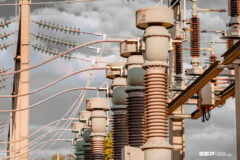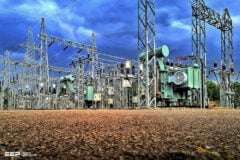Power triangle & power factor
This article will shed some light on how adding capacitors gives the distribution system the necessary reactive power to return the power factor to the required level. Capacitors act as a source of reactive energy, which accordingly reduces the reactive power that the energy source must supply. The power factor of the system is therefore improved.

In an installation consuming reactive power Q1 (Diagram 1), adding a capacitor bank generating a reactive compensation power Qc (Diagram 2) improves the overall efficiency of the installation. The reactive power Q1 initially supplied by the source is reduced to a new Q2 value (Diagram 3), the φ angle is smaller and the cosine of this angle is improved (moves towards 1).
The current consumption is also reduced.
Figure 1 – Power triangle


Power compensation enables the interests of the user and those of the energy distribution company to be combined, by improving the efficiency of installations through better use of the available power by limiting the consumption of reactive energy that is not only unnecessary and expensive but also a source of overcurrents in conductors.
The example below shows how, by “increasing” the power factor from 0.7 to 0.95, for the same active power of 100 kW, the apparent power S (in VA), in comparison to that which actually has to be supplied has been reduced by 35%.
Figure 2 – An example of increasing the power factor from 0.7 to 0.95


comparison to that which actually has to be supplied has been reduced by 35%.
Power factor calculations:
- Before PF = 100/142 = 0.70 or 70%
- After PF = 100/105 = 0.95 or 95%
When the cos changes from an initial value cos φ1 to a final value cos φ2, as a general rule, the ohmic losses are reduced by: (1 – (cos φ1/cos φ2)²) × 100 as a %
Thus changing from a cosφ of 0.7 to 0.95 reduces the losses by 45%. A poor cosφ, therefore, causes voltage drops in the conductors. The voltage drop in an electric line can be calculated using the formula: ΔU = I ( R cosφ + L sinφ). The maximum power that can be transmitted in an AC system is calculated using the following formulae:
P = U I cosφ for single-phase and P = U I √3 cosφ for three-phase.
Improving the cos φ from an initial value cos φ1 to a final value cos φ2, for X (W) power used, releases an additional usable apparent power of S (kVa) = p(kW) × ((1/cos φ1) – (1/cos φ2)). Therefore a 1000 kVa transformer delivering a load of 700 kW with a cosφ of 0.7 is at its maximum load.
By improving the cos φ from 0.7 to 0.95, an additional available active power of 250 kW is released.
- Determining the compensation by theoretical calculation
- Determining the compensation based on the billing information
- Calculation based on measured elements
- Conversion table
1. Determining the compensation by theoretical calculation
1.1. Based on the cosϕ and the currents
Figure 3 – Determining compensation based on the cosϕ and the currents


Where:
- Ia – active current
- Iti – initial apparent current (before correction)
- Itf – final apparent current (after correction)
- φi – phase shift before the correction
- φf – phase shift after correction
- Iri – reactive current before the correction
- Irf – reactive current after correction
- Ia = Iti cos φi = Itf cos φf
The final current is reduced so that: Itf = Iti cosφi/cosφf
Pf/Pi = cosφf / cosφi
The reactive power compensation Qc can be defined as being the difference between the initial power (Qi = U×Irf×sinφi) and the reactive power obtained after
compensation (Qf = U×Irf×sinφf):
Qc = U × (Iri – Irf)·(sinφi – sinφf)
1.2. Based on tanφ and powers
Calculation based on the powers enables the required tan value to be used directly to determine the reactive power compensation to be installed.
Figure 4 – Determining compensation based on the tan ϕ and powers


- Initial value of tan φi = Q/P
- Required value of tan φf = Q’/P
- Qc = Q – Q’ i.e. Qc = P (tan φi – tan φf)
The power compensation is very easy to calculate from the required tan value. The capacitance value in farads is calculated as follows:
C = P (tan φi – tan φf) / ωU2
1.3 Over-compensation
When the power compensation (Qc1) is determined correctly, its value must be as close as possible to the reactive power Q to be compensated and the phase shift angle (ϕ’) tends towards 0. If the compensation (Qc2) is greater than the reactive power, the phase-shift angle (φ”) increases, and the apparent power S” increases.
The circuit becomes predominantly capacitive. This leads to an increase in the current consumed which defeats the purpose.
Figure 5 – Over-compensation


Over-compensation also tends to increase the voltage applied to the installation. It must be avoided. It is generally considered that it should not exceed 1.15 times the power to be compensated. The use of power factor controllers and step capacitor banks avoids problems of overcompensation.
Figure 6 – Over-compensation currents


Over-compensation (Ic >Ir), increases the apparent current consumed and also increases the voltage applied to the equipment. The illustration of vectors V2S (with over-compensation) and V2 (with appropriate compensation) shows this phenomenon, which must be avoided.
Care must be taken when choosing energy compensation.
2. Determining the compensation based on the billing information
As pricing and metering methods can vary from country to country, only a general process for assessing the need for reactive compensation, using the energy distribution company’s readings or bills, will be described here. Depending on the pricing method, access to the reactive energy consumption (kvarh) may be direct, together with the number of hours to which this value refers. it is then billed proportionately.
This is generally the case for high power connections with one or more MV/LV transformers dedicated to the installation.
For lower power connections, the reactive power consumption may be indirectly billed by the overconsumption of the apparent power (in VA) that is causes. For a “monitored power” connection, it is then billed according to the amounts by which the subscribed nominal apparent power is exceeded.
2.1. With reactive energy metering
In general, billing is applied when the tanφ exceeds a certain value (0.4 for example) and also according to time periods (peak times) or seasons (winter). The following calculation method, given for information purposes only, can be used to calculate the capacitor banks to be installed at the supply end of an installation with the regular, repetitive operation.
For random or sequenced operation, automatic banks, which switch on according to the load, are recommended so as not to “overcompensate” the installation.
- Analyze the bills for the period for which the reactive power is charged
- Select the month in which the bill is highest (kvarh to be billed)
- Evaluate the number of hours the installation operates per month (NBhm) (for example high-load times and peak times) during which the reactive energy is billed.
The amount of reactive energy billed Erfac will be: Erfac = Er – Ea×tanφ = Er – (0.4×Ea)
Power Qc of the capacitors to be installed: Qc = Er/NBhm
- Erfac – Reactive energy billed each month (in kvarh)
- Ea (kWh) – Monthly active energy consumption for the period and the times defined above
- Er (kvarh) – Reactive energy consumption for the same period
- NBhm – Number of hours operation per month for which Er is billed
For example, if the permitted value of tanφ changes to 0.31, the amount of reactive energy billed Erfac will become:
Erfac = Er – Ea×tanφ = Er – (0.31×Ea)
Figure 7 – Multifunction digital measurement control unit with reactive energy metering


2.2. Without reactive energy metering
In this type of supply contract (for example, “yellow tariff” – low power supply – in France), the reactive energy consumption is not shown on the electricity bill. It is charged indirectly, based on the consumption of apparent power in kVA. The distribution company charges a “fixed charge” that depends on the subscribed apparent power. Above this power, the consumer pays penalties. this is the principle of “monitored power”.
Reactive energy compensation reduces the fixed charge by reducing the subscribed apparent power. It also enables the amounts over and above this subscribed demand to be limited (billing of the additional kVA over the limit).
To determine the reactive power value to be installed, the capital investment costs of the capacitors must be compared with the savings on the fixed charge paid to the distribution company.
Nowadays reactive power is only billed for high-power installations, using direct metering (of the reactive power in kvar) or indirect metering (of the apparent power in kVA). Low power installations are billed in kW and therefore their only disadvantage is the limitation of the available current.
For responsible energy management with the aim of making better use of resources, and in view of the increasing numbers of receivers with a poor power factor (electronic power supplies, low consumption light bulbs), billing should logically move towards taking reactive power into account, which the next generation of “intelligent” meters will be capable of doing. Compensation of small installations will then come into its own.
Recommended Reading – Mastering single line and wiring diagrams: Using circuit breaker for MV power factor correction
Mastering single line and wiring diagrams: Using circuit breaker for MV power factor correction
2.3 Example of potential savings on an installation billed in kVA
An installation usually operates with a subscribed demand S of 160 kVA. The average value of tanφ read is 0.75 (estimated cos 0.8). At peak demand, the power reached is close to the subscribed demand. At its peak, this installation therefore consumes an active power P = UI√3 cosφ = 160 × 0.8 = 128 kW and a reactive power Q = P × tanφ = 128 × 0.75 = 96 kvar.
Setting a target value of tanφ at 0.4, it will be possible to reduce the reactive power consumption to Q = P (tan φi – tan φf) = 128 × (0.75 – 0.4) = 45 kvar.
- The saving in the reactive power consumption is G = 96 – 45 = 51 kvar.
- The power compensation Qc could be 50 kvar by default.
- The power S for the subscribed demand then becomes S = √(P2 + Q2) = √(128)2 + (51)2 = 138 kVA.
This simplified approach may lead to a risk of overcompensation when the installation is not subject to high loads (for example, in the summer). This is why more or less detailed readings, depending on the complexity of the consumption cycles, are always recommended in practice.
Further Reading – Five actions to achieve excellent energy savings in old electrical installations
Five actions to achieve excellent energy savings in old electrical installations
3. Calculation based on measured elements
Power measurements have changed a great deal due to the increasing complexity of the signals and current waveforms absorbed and as a consequence metering equipment has also advanced, to such a degree that one no longer talks about power measurement but power analysis.
3.1. Power measurement
Power measurement is a one-off measurement that can provide useful information as to the operating conditions of an installation, but it remains more or less limited depending on the equipment used (direct access to cosφ, tanφ, and harmonic powers), may be marred by errors due to the waveforms and frequencies of the signals, and above all only provides an image at a given moment.
- In single-phase systems, the power can be measured (using a wattmeter), and also the voltage and the current. the p/ui ratio gives the cosϕ.
- In three-phase systems, power P1 and P2 can be measured, using the two-wattmeters method.
Figure 8 – Two-wattmeters method


- P1 = U13×I1×cos (U13×I1) = U13×I1
- ⇒ P2 = U23×I2·cos (U23×I2) = U23×I2
- I1 + I2 + I3 = 0 ⇒ I3 = – I1 – I2
- ⇒ P = V1×I1 + V2×I2 – V3×I1 – V3×I2
- P = I1 (V1 – V3) + I2 (V2 – V3) = I1×U13 + I2×U23 = P1 + P2
The total power in three-phase systems is obtained by adding together the readings from two wattmeters. The tanϕ is calculated the same way:
tanϕ = √3·(P1 – P2) / (P1 + P2).
In a balanced state, the reactive power Q can be measured using a single wattmeter. It is demonstrated that cos(U13×I1) = cos(π/2 – ϕ). The reactive power in three-phase systems is written Q = √3×P.
Figure 9 – A single-wattmeter method


P = U23×I1×cos (U13×I1) = U23×I1
3.2 Calculation for energy suppliers (small power plants)
For this type of installation, the independent power producer must supply the distribution company with an amount of reactive energy equal to a contractual share of its production of active energy during high-load times and peak periods.
In this case, the calculation of the capacitor bank must take the following into account:
- The on-load active consumption of the generator
- The on-load reactive consumption of the MV/LV transformer (if there is one)
- The reactive energy to be supplied (contractual share of the active energy produced)
4. Conversion table
This table can be used to calculate (based on the power of a receiver in kW) the power of the capacitors to change from an initial power factor to a required power factor. It also gives the equivalence between cosϕ and tanϕ.
Table 1 – Power of the capacitors to be installed (in kvar) per kW of load


Example: 200 kW motor – cosϕ = 0.75 – cosϕ to be achieved: 0.93 – Qc = 200 × 0.487 = 98 kvar.
Source: Legrand











this is very much helpful & thanks for sharing knowledge.
excelente pagina con excelentes temas tecnicos
Expression is wonderful, I personally found it very successful
Good article. In order to disseminate the technical knowledge can we share these articles on other technical forums? It will benefit engineering fraternity immensely. Your early reply shall be highly appreciated.
thanks,
Ulhas Vajre